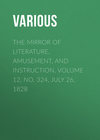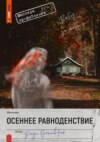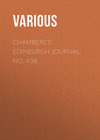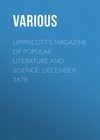Kitabı oku: «The Mirror of Literature, Amusement, and Instruction. Volume 12, No. 324, July 26, 1828»
KINGSTON NEW BRIDGE
Through many a bridge the wealthy river roll'd.
SOUTHEY.
The annexed picturesque engraving represents the new bridge1 from Kingston-upon-Thames to Hampton-Wick, in the royal manor of Hampton Court. It is built of Portland stone, and consists of five elliptical arches, the centre arch being 60 feet span by 19 in height, and the side arches 56 and 52 feet span respectively. The abutments are terminated by towers or bastions, and the whole is surmounted by a cornice and balustrade, with galleries projecting over the pier; which give a bold relief to the general elevation. The length of the bridge is 382 feet by 27 feet in width. It is of chaste Grecian architecture, from the design of Mr. Lapidge, to whose courtesy we are indebted for the original of our engraving. The building contract was undertaken by Mr. Herbert for £26,800. and the extra work has not exceeded £100. a very rare, if not an unprecedented occurrence in either public or private undertakings of this description. The first stone was laid by the Earl of Liverpool, November 7, 1825, and the bridge was opened in due form by her royal highness the Duchess of Clarence, on July 17, 1828.
Kingston is one of the most picturesque towns on the banks of the Thames; and its antiquarian attractions are of the highest order. It was occupied by the Romans, and in aftertimes it was either a royal residence or a royal demesne, so early as the union of the Saxon Heptarchy; for there is a record extant of a council held there in 838, at which Egbert, the first king of all England, and his son Athelwolf were present; and in this record it is styled Kyningenstum famosa ilia locus. Some of our Saxon kings were also crowned here; and adjoining the church is a large stone, on which, according to tradition, they were placed during the ceremony. Many interesting relics have from time to time been discovered in illustration of these historical facts, and till the year 1730, the figures of some of the above kings and that of king John (who chartered the town) were preserved in a chapel adjoining the above spot. In that year, however, the chapel fell, and with it were demolished the royal effigies.2 Mr. Lysons, with his usual accuracy, enumerates nine kings who were crowned here. Kingston formerly sent members to parliament, till, by petition, the inhabitants prayed to be relieved from the burden!
At Hampton Wick, the village on the opposite bank, resided the witty but profligate Sir Richard Steele, in a house which he whimsically denominated "the hovel;" and "from the Hovel at Hampton Wick, April 7, 1711," he dedicated the fourth volume of the Tatler to Charles, Lord Halifax. This was probably about the time he became surveyor of the royal stables at Hampton Court, governor of the king's comedians, a justice of the peace for Middlesex, and a knight.
ARCHBISHOPS OF CANTERBURY
The first Archbishop of Canterbury was Austin, appointed by King Ethelbert, on his conversion to Christianity, about the year 598. Before the coming of the Saxons into England, the Christian Britons had three Archbishops, viz. of London, York, and Caerleon, an ancient city of South Wales. The Britons being driven out of these parts, the Archbishoprick of London became extinct; and when Pope Gregory the Great had afterwards sent thither Augustine, and his fellow-labourer to preach the Gospel to the then heathen Saxons, the Archiepiscopal See was planted at Canterbury, as being the metropolis of the kingdom of Kent, where King Ethelbert had received the same St. Augustine, and with his kingdom was baptized, and embraced the doctrines of Christianity before the rest of the Heptarchy. The other Archbishoprick of Caerleon was translated to St. David's in Pembrokeshire, and afterwards wholly to the See of Canterbury; since which, all England and Wales reckon but two Archbishops, Canterbury and York. The following Archbishops have died at Lambeth Palace;—Wittlesey, in 1375; Kemp, 1453; Dean, 1504; all buried in Canterbury Cathedral: Cardinal Pole, 1558, after lying in state here 40 days was buried at Canterbury; Parker, 1575, buried in Lambeth Chapel; Whitgift, 1604, buried at Croydon; Bancroft, 1610, buried at Lambeth; Juxon, 1663, buried in the chapel of St. John's College, Oxford; Sheldon, 1667, buried at Croydon; Tillotson, 1694, buried in the church of St. Laurence Jewry, London; Tennison, 1715; and Potter, 1747, both buried at Croydon; Seeker, 1768; Cornwallis, 1783, and Moore, 1805, all buried at Lambeth. In 1381, the Archbishop, Simon of Sudbury, fell a victim to Wat Tyler and his crew, when they attacked Lambeth Palace.
P. T. W.
DAYS OF FLY FISHING
That an ex-president (Sir Humphry Davy) of the Royal Society should write a book on field sports may at first sight appear rather unphilosophical; although it is not more fanciful than Bishop Berkeley's volume on tar water, Bishop Watson's improvement in the manufacture of gunpowder, Sir Walter Scott writing a sermon, or a Scotch minister inventing a safety gun, and, as we are told, presenting the same to the King in person. Be this as it may, since our first acquaintance with the "prince of piscators," the patriarch of anglers, Isaak Walton, it has seldom been our lot to meet with so pleasant a volume as Salmonia, or Days of Fly Fishing, to whose contents we are about to introduce our readers.
In our last number we gave a flying extract, entitled, "Superstitions on the Weather," being a fair specimen of the very agreeable manner of the digressions in the above work, which is, perhaps, less practical than it might have been; but this defect is more than atoned for in the author's felicitous mode of intermingling with the main subject, some of the most curious facts and phenomena in natural history and philosophy so as to familiarize the angler with many causes and effects which altogether belong to a higher class of reading than that of mere amusement. All this, too, is done in a simple, graceful, and flowing style, always amusive, and sometimes humorously illustrative—advantages which our philosophical writers do not generally exhibit, but which are more or less evident in every page of Sir Humphry Davy's writings.
Salmonia consists of a series of conversations between four characters—Halieus,3 Poietes, Physicus, Ornither. In the "First Day" we have an ingenious vindication of fly fishing against the well-known satire of Johnson4 and Lord Byron, and the following:—
Halieus.—A noble lady, long distinguished at court for pre-eminent beauty and grace, and whose mind possesses undying charms, has written some lines in my copy of Walton, which, if you will allow me, I will repeat to you:—
Albeit, gentle Angler, I
Delight not in thy trade,
Yet in thy pages there doth lie
So much of quaint simplicity,
So much of mind,
Of such good kind.
That none need be afraid,
Caught by thy cunning bait, this book,
To be ensnared on thy hook.
Gladly from thee, I'm lur'd to bear
With things that seem'd most vile before,
For thou didst on poor subjects rear
Matter the wisest sage might hear.
And with a grace,
That doth efface
More laboured works, thy simple lore
Can teach us that thy skilful lines,
More than the scaly brood confines.
Our hearts and senses too, we see,
Rise quickly at thy master hand,
And ready to be caught by thee
Are lured to virtue willingly.
Content and peace,
With health and ease,
Walk by thy side. At thy command
We bid adieu to worldly care.
And joy in gifts that all may share.
Gladly with thee, I pace along.
And of sweet fancies dream;
Waiting till some inspired song,
Within my memory cherished long,
Comes fairer forth.
With more of worth;
Because that time upon its stream
Feathers and chaff will bear away,
But give to gems a brighter ray.
And though the charming and intellectual author of this poem is not an angler herself, yet I can quote the example of her lovely daughters to vindicate fly fishing from the charge of cruelty, and to prove that the most delicate and refined minds can take pleasure in this innocent amusement.
Gay's passionate love for angling is well known; it was his principal occupation in the summer at Amesbury; and "the late excellent John Tobin, author of the Honey Moon, was an ardent angler." Among heroes, Trajan was fond of angling. Nelson was a good fly-fisher, and continued the pursuit even with his left hand; and, says the author, "I have known a person who fished with him at Merton, in the Wandle. Dr. Paley was so much attached to this amusement, that when the Bishop of Durham inquired of him when one of his most important works would be finished, he said, with great simplicity and good-humour, 'My lord, I shall work steadily at it when the fly-fishing season is over.'"—Then we have a poetical description of river scenery, till two of the party arrive at the following conclusions:—
I have already admitted the danger of analyzing, too closely, the moral character of any of our field sports; yet I think it cannot be doubted that the nervous system of fish, and cold-blooded animals in general, is less sensitive than that of warm-blooded animals. The hook usually is fixed in the cartilaginous part of the mouth, where there are no nerves; and a proof that the sufferings of a hooked fish cannot be great is found in the circumstance, that though a trout has been hooked and played for some minutes, he will often, after his escape with the artificial fly in his mouth, take the natural fly, and feed as if nothing had happened; having apparently learnt only from the experiment, that the artificial fly is not proper for food. And I have caught pikes with four or five hooks in their mouths, and tackle which they had broken only a few minutes before; and the hooks seemed to have had no other effect than that of serving as a sort of sauce piquante, urging them to seize another morsel of the same kind.—The advocates for a favourite pursuit never want sophisms to defend it. I have even heard it asserted, that a hare enjoys being hunted. Yet I will allow that fly-fishing, after your vindication, appears amongst the least cruel of field sports.
We must, however, confine ourselves to a few colloquial extracts from the practical portion of the volume; as
Flies on the Wandle, &c.
Orn.—Surely the May-fly season is not the only season for day-fishing in this river? [the Wandle.]—Hal. Certainly not. There are as many fish to be taken, perhaps, in the spring fishing; but in this deep river they are seldom in good season till the May-fly has been on, and a fortnight hence they will be still better than even now. In September there may be good fish taken here; but the autumnal flies are less plentiful in this river than the spring flies—Phys, Pray tell me what are the species of fly which take in these two seasons.—Hal. You know that trout spawn or deposit their ova, &c. in the end of the autumn or beginning of winter, from the middle of November till the beginning of January, their maturity depending upon the temperature of the season, their quantity of food, &c. They are at least six weeks or two months after they have spawned before they recover their flesh; and the time when these fish are at the worst, is likewise the worst time for fly-fishing, both on account of the cold weather, and because there are fewer flies on the water than at any other season. Even in December and January there are a few small gnats or water-flies on the water in the middle of the day, in bright days, or when there is sunshine. These are generally black, and they escape the influence of the frost by the effects of light on their black bodies, and probably by the extreme rapidity of the motions of their fluids, and generally of their organs. They are found only at the surface of the water, where the temperature must be above the freezing point. In February a few double-winged water-flies, which swim down the stream, are usually found in the middle of the day, such as the willow-fly; and the cow-dung-fly is sometimes carried on the water by winds. In March there are several flies found on most rivers. The grannam, or green-tail-fly, with a wing like a moth, comes on generally morning and evening, from five till eight o'clock, A.M. in mild weather, in the end of March and through April. Then there are the blue and the brown, both ephemerae, which come on, the first in dark days, the second in bright days; these flies, when well imitated, are very destructive to fish. The first is a small fly, with a palish yellow body, and slender, beautiful wings, which rest on the back as it floats down the water. The second, called the cob in Wales, is three or four times as large, and has brown wings, which likewise protrude from the back, and its wings are shaded like those of a partridge, brown and yellow brown. These three kinds of flies lay their eggs in the water, which produce larvae that remain in the state of worms, feeding and breathing in the water till they are prepared for their metamorphosis, and quit the bottoms of the rivers, and the mud and stones, for the surface, and light and air. The brown fly usually disappears before the end of April, likewise the grannam; but of the blue dun there is a succession of different tints, or species, or varieties, which appear in the middle of the day all the summer and autumn long. These are the principal flies on the Wandle—the best and clearest stream near London. In early spring these flies have dark olive bodies; in the end of April and the beginning of May they are found yellow; and in the summer they become cinnamon coloured; and again, as the winter approaches, gain a darker hue. I do not, however, mean to say that they are the same flies, but more probably successive generations of ephemerae of the same species. The excess of heat seems equally unfavourable, as the excess of cold, to the existence of the smaller species of water-insects, which, during the intensity of sunshine, seldom appear in summer, but rise morning and evening only. The blue dun has, in June and July, a yellow body; and there is a water-fly which, in the evening, is generally found before the moths appear, called the red spinner. Towards the end of August, the ephemerae appear again in the middle of the day—a very pale, small ephemera, which is of the same colour as that which is seen in some rivers in the beginning of July. In September and October this kind of fly is found with an olive body, and it becomes darker in October and paler in November. There are two other flies which appear in the end of September and continue during October, if the weather be mild; a large yellow fly, with a fleshy body, and wings like a moth; and a small fly with four wings, with a dark or claret coloured body, that when it falls on the water has its wings like the great yellow fly, flat on its back. This, or a claret bodied fly, very similar in character, may be likewise found in March or April, on some waters. In this river I have often caught many large trout in April and the beginning of May, with the blue dun, having the yellow body; and in the upper part of the stream below St. Albans, and between that and Watford, I have sometimes, even as early as April, caught fish in good condition; but the true season for the Colne is the season of the May-fly. The same may be said of most of the large English rivers containing large trouts, and abounding in May-fly—such as the Test and the Kennett, the one running by Stockbridge, the other by Hungerford. But in the Wandle, at Carshalton and Beddington, the May-fly is not found; and the little blues are the constant, and, when well imitated, killing flies on this water; to which may be joined a dark alder-fly, and a red evening fly. In the Avon, at Ringwood and Fordingbridge, the May-fly is likewise a killing fly; but as this is a grayling river, the other flies, particularly the grannam and blue and brown, are good in spring, and the alder-fly or pale blue later, and the blue dun in September and October, and even November. In the streams in the mountainous parts of Britain, the spring and autumnal flies are by far the most killing. The Usk was formerly a very productive trout-stream, and the fish being well fed by the worms washed down by the winter floods, were often in good season, cutting red, in March and the beginning of April: and at this season the blues and browns, particularly when the water was a little stained after a small flood, afforded the angler good sport. In Herefordshire and Derbyshire, where trout and grayling are often found together, the same periods are generally best for angling; but in the Dove, Lathkill, and Wye, with the natural May-fly many fish may be taken; and in old times, in peculiarly windy days, or high and troubled water, even the artificial May-fly, according to Cotton, was very killing.




















